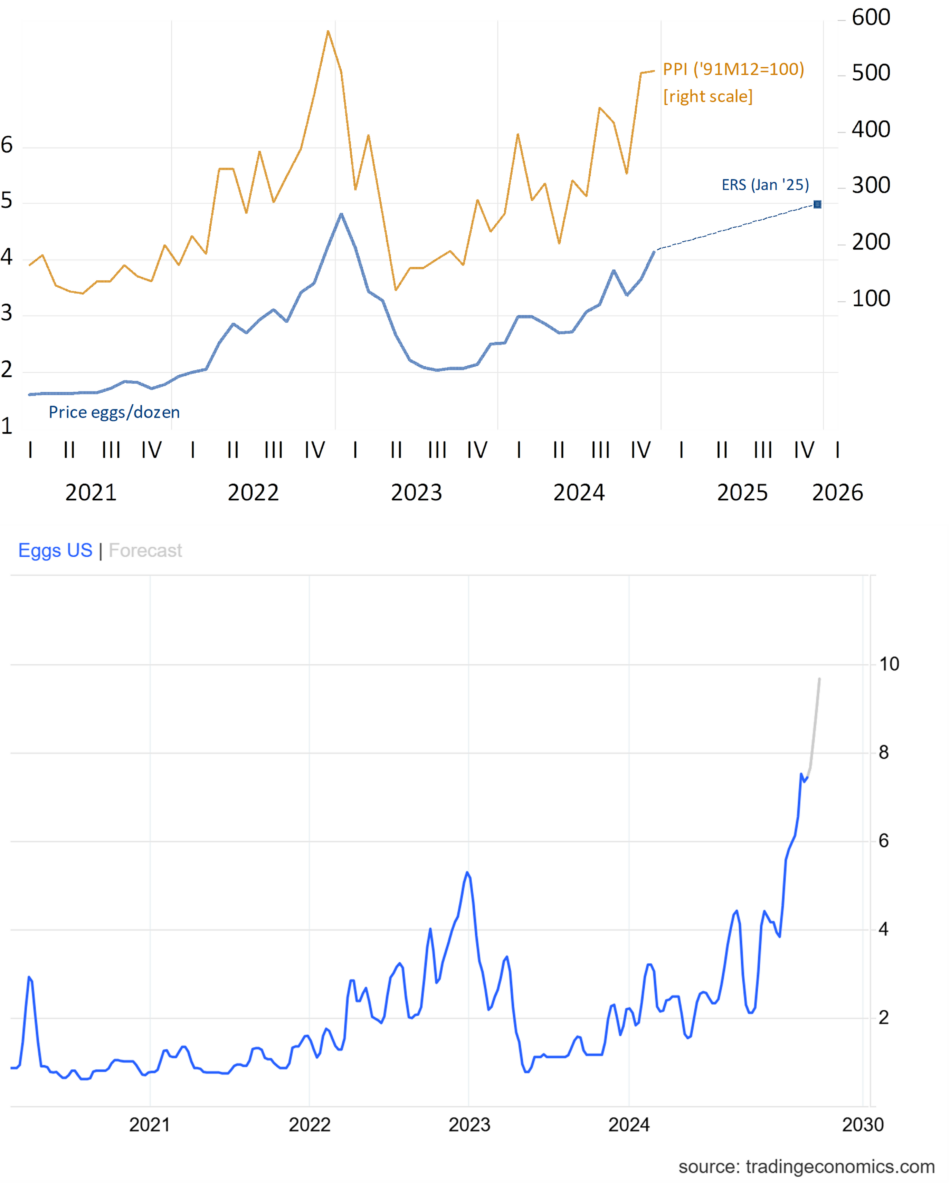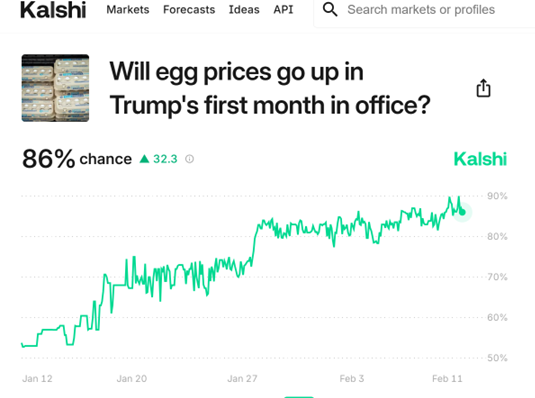Tomorrow, we’ll get a reading on January egg prices at the consumer level. With futures prices at about $5.2 in December and $6.65 in January, I’d guess retail egg prices will have gone up. Futures are at $7.65 so far in February.
Figure 1: Top panel – Consumer Price of Dozen Eggs (blue, left scale), ERS forecast of January 2025 for end 2024 (blue square, left scale), both in $, and PPI for fresh eggs (tan, right scale), 1991M12=100. Bottom panel: Trading Economics futures price for dozen eggs (blue), and TradingEconomics model and analyst based forecast (gray). Source: BLS, ERS, TradingEconomics.com.
The USDA’s Economic Research Service January 2025 forecast indicates a $5/dozen price by end-2025. This forecast is based on a time series model. TradingEconomics’ forecast of $9.67/dozen futures price is based on their proprietary macroeconomic model, and analysts’ forecasts, of undisclosed weighting. However, their forecast clearly includes a judgmental component, such as egg-laying hen stocks, and projections of bird flu prevalence.
Could egg prices be lower by end-2025 than in January 2025? The ERS forecast 95% confidence interval encompassed a price reduction. I’m dubious, although a miracle could happen with respect to to bird flu (although I suppose we ain’t gonna get a vaccine super-fast with all the cuts to medical research the Trump administration wishes to impose). A catastrophic recession could also push down prices. However, since eggs are a staple — rather than a luxury good — this is hardly seems implausible.
Implications for grocery prices? My guess is that in the 2023 CPI weights, eggs account for about 2.2% of the food-at-home component of the CPI. A 13% December-to-December increase in egg prices accounts for a 0.3 ppts higher food-at-home CPI component.
Addendum: Betting on February egg prices up relative to January.
Source: https://kalshi.com/markets/kxeggs/egg-prices accessed 12:30 CT


Here’s a look at what poultry farms are doing to fight the spread of bird flu:
https://kffhealthnews.org/news/article/bird-flu-egg-farmers-biosecurity-backyard-flocks-pandemic-risk/amp/
Two things to note with regard to government’s role in dealing with bird flu: 1) Farms rely on Department of Agriculture guidance in resisting the spread of disease. 2) Inoculation has worked to stall bird flu in the past and could be used now. Because poultry exports could be harmed, there is reluctance to vaccinate egg producing flocks. (Seems like this could be addressed somehow?)
Because government has the lead in determining how farms will deal with bird flu, this is a bad time for chaos at the Ag Department.
Notice what’s going on with inflation expectations:
https://fred.stlouisfed.org/graph/?g=1DDEQ
The five-year breakeven is at its highest level since Q3 2002, while the 5-year/5-year forward rate is steady around 2.3%. In other words, markets are pricing in an increase in inflation during the Trump administration, but not thereafter.
I’m wondering what people think of this https://www.politico.com/news/magazine/2025/02/11/democrats-tricked-strong-economy-00203464
I don’t know anything about the author.
Jacob: Noah Smith recommends you read this thread https://x.com/jmhorp/status/1889768025651577149
Thank you
By the way, y’all know that poultry flocks are insured, right? So we have another insurance market facing very large claims because of a natural event. This means higher premiums, which means that eggs production is more expensive.
Shouldn’t our government be taking action to deal with bird flu?
I want to know why trump has not yet controlled my cost of living? eggs are through the roof. mortgage rates are astronomical! I thought trump was going to fix all of these things on day 1. instead, he seems more interested in destroying the federal government and obtaining real estate on the mediterranean coast and arctic. trump is nothing but a con man.
and let me point out a conspiracy. we have tariffs that are going to be very bad for products imported from Mexico and Canada. these are friends who are going to get hurt. and the American businesses these tariffs will hurt are automobile companies. why is trump targeting our friends and major automobile manufacturers with high tariffs?
and why is china, who trump has argued is our greatest threat, only getting a fraction of of the promised tariff war? why are we all of a sudden giving a pass to china?
enter Elon Musk. musk has quite a bit of business interest in china, and would very much like to keep the Chinese government from targeting American businesses in china. musk has a large Tesla (and other) business in china today. he benefits from the idle threats that do not actually materialize.
and the tariffs on Mexico and Canada? major us auto manufacturers are going to take a beating from these tariffs. these manufacturers are the competitors of Tesla in the United States, and the tariffs will help Tesla immensely in this battle of competitors. musk benefits greatly from these unprovoked tariffs, which are larger than the tariffs imposed upon our enemy china (in trump’s words).
makes you wonder who exactly is leading this tariff charge? president musk? in Star Wars terms, perhaps he is the emperor…
i get daily email updates from the Center for Infectious Disease Research and Policy at the University of Minnesota,, read most of what they publish, ( https://www.cidrap.umn.edu/ ), and judge bird flu to be getting worse….it seems there’s been a couple million bird layer farms hit every week for the past few weeks, during which time the 2nd largest operation in the US had to euthanize 2.6 million birds…. i wouldn’t count on eggs being available for Easter…
as an aside, my wife tells me her standing order for frozen chicken was cancelled because there was none available….their estimated time to refill that pipeline was 4 months…
“In order for the campaign to effectively slow or stop the outbreak in the U.S., it would have to be widely implemented, and there are no policies currently in place to mandate this sort of vaccination and to protect the financial investment of the farmers.
“Finally, the vaccine is not a silver bullet and does not stop the main source of bird flu, which is spread within and from wild birds.”
https://www.newsweek.com/bird-flu-map-update-poultry-cdc-usda-2020528
We certainly seem to see a lot of interesting viruses and destructive pests offsetting some of the savings from cheap goods (including emerald ash borer, Asian carp, and now the lanternfly) coming from our trading partner. It’s as if the rush for bargains has cancelled the need for inspections.
In 1996, highly pathogenic avian influenza H5N1 virus is first identified in domestic waterfowl in Southern China. The virus is named A/goose/Guangdong/1/1996. In 1997, H5N1 poultry outbreaks happen in China and Hong Kong with 18 associated human cases (6 deaths) in Hong Kong. This virus would go on to cause more than 860 human infections with a greater than 50% death rate.
https://archive.cdc.gov/www_cdc_gov/flu/avianflu/communication-resources/bird-flu-origin-infographic.html
Yup, the price of eggs doubled. I wonder why? And why hasn’t Trump fixed the problem yet? He’s been in office more than three whole weeks already.
trump promised to fix a lot of things on day 1. had not really fixed anything. exactly how much time should I give him? also, bruce, are you telling me I should not believe everything that trump says, because it may not be true?
He has been in office three whole weeks, during which time he has shut down U.S. foreign aid, sacked inspectors general, imposed tariffs, fiddled with personnel procedures – all of which is of questionable legality – and done nothing about bird flu. Fiddling while Rome burns, and all that.
This is a problem of priorities. He hasn’t tried to do anything about bird flu. The guy is a convicted felon, and he seem unwilling to do anything which doesn’t violate the law. He didn’t want to do anything about Covid, but we had mechanisms in place, so things got done despite his lack of leadership. Now, he’s dismantling the mechanisms we’ve worked so long to build.
But you go ahead and make excuses for the rapist-in-chief. You do you.
Along with his other lies, yesterday in an Oval Office press conference Musk claimed that there were people 150 years old still fraudulently receiving Social Security checks. This is a flat out obvious lie which you can see with your own math.
There is only one person who would be 150 years old receiving Social Security and that is Ida May Fuller, who is famous for receiving the very first Social Security check 85 years ago. And no, her family is not still receiving her checks. Musk is just lying.
And then there was his lie about $50 million of condoms being sent to the Gaza strip. When called on his lie, Musk said that no one hits 1000 and sometimes makes an error. But this wasn’t just an error. It’s only source was a silly internet meme posted by one of Musk’s favorite posters called Catturd and promoted on Musk’s social media platform. There were no facts behind it at all. It was completely made up on twitter. Not one dollar of USAID went to Gaza for condoms. In fact the entire amount spent by USAID in the last year in the entire world for condoms for family planning and HIV prevention was less than $10 million.
Musk is just like his mentor Trump, a unregenerate sociopathic liar. This has been conclusively proven many times over The press should never take any statement by Musk at face value without verifying it independently. To do otherwise is just maliciously misinforming the public.
apparently little x told him to shut the eff up, and that he should leave because his isn’t the president, daddy is. and trump took it in silence. musk’s toddler put him in his place. president musk owns trump. makes you wonder what else of trump’s is owned by musk.